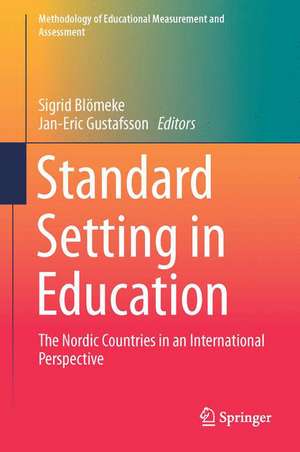Standard Setting in Education: The Nordic Countries in an International Perspective: Methodology of Educational Measurement and Assessment
Editat de Sigrid Blömeke, Jan-Eric Gustafssonen Limba Engleză Hardback – 3 mar 2017
Standard setting targets crucial societal objectives by defining educational benchmarks at different achievement levels, and provides feedback to policy makers, schools and teachers about the strengths and weaknesses of a school system. Given that the consequences of standard setting can be dramatic, the quality of standard setting is a prime concern. If it fails, repercussions can be expected in terms of arbitrary evaluations of educational policy, wrong turns in school or teacher development or misplacement of individual students. Standard setting therefore needs to be accurate, reliable, valid, useful, and defensible.
However, specific evidence on the benefits and limits of different approaches to standard setting is rare and scattered, and there is a particular lack with respect to standard setting in the Nordic countries, where the number of national tests is increasing and there are concerns about the time and effort spent on testing at schools without feedback being provided. Addressing this gap, the book offers a discussion on standard setting by respected experts as well as profound and innovative insights into fundamental aspects of standard setting including conclusions for future methodological and policy-related research.
| Toate formatele și edițiile | Preț | Express |
|---|---|---|
| Paperback (1) | 892.42 lei 6-8 săpt. | |
| Springer International Publishing – 7 aug 2018 | 892.42 lei 6-8 săpt. | |
| Hardback (1) | 898.58 lei 6-8 săpt. | |
| Springer International Publishing – 3 mar 2017 | 898.58 lei 6-8 săpt. |
Preț: 898.58 lei
Preț vechi: 1095.83 lei
-18% Nou
Puncte Express: 1348
Preț estimativ în valută:
171.95€ • 183.87$ • 143.36£
171.95€ • 183.87$ • 143.36£
Carte tipărită la comandă
Livrare economică 18 aprilie-02 mai
Preluare comenzi: 021 569.72.76
Specificații
ISBN-13: 9783319508559
ISBN-10: 3319508555
Pagini: 367
Ilustrații: VI, 339 p. 51 illus., 26 illus. in color.
Dimensiuni: 155 x 235 x 21 mm
Greutate: 0.66 kg
Ediția:1st ed. 2017
Editura: Springer International Publishing
Colecția Springer
Seria Methodology of Educational Measurement and Assessment
Locul publicării:Cham, Switzerland
ISBN-10: 3319508555
Pagini: 367
Ilustrații: VI, 339 p. 51 illus., 26 illus. in color.
Dimensiuni: 155 x 235 x 21 mm
Greutate: 0.66 kg
Ediția:1st ed. 2017
Editura: Springer International Publishing
Colecția Springer
Seria Methodology of Educational Measurement and Assessment
Locul publicării:Cham, Switzerland
Cuprins
1. Introduction.- PART 1: Fundamental Questions in Standard Setting.- 2. Using Empirical Results to Validate Performance Standards.- 3. Weaknesses of the Traditional View of Standard Setting and a Suggested Alternative.- 4. Standard Setting: Bridging the World of Research and Policy Making.- 5. Standard Setting in PISA and TIMSS and How these Procedures Can Be Used Nationally.- 6. In the Science and Practice of Standard Setting: Where is the Science??- PART 2: Standard Setting in the Nordic Countries.- 7. Standard Setting in Denmark: Challenges through Computer-based Adaptive Testing.- 8. Experiences with Standards and Criteria in Sweden.- 9. Validating Standard Setting in Sweden: Comparing Judgmental and Statistical Linking.- 10. National Tests in Norway: An Undeclared Standard in Education?- 11. Setting Standards for Multistage Tests of Norwegian for Adult Immigrants.- 12. Standard Setting in a Formative Assessment of Digital Responsibility Among Norwegian Eighth Graders.- 13. Assessment for Learning and Standards: A Norwegian Strategy and Its Challenges.- 14. How Do Finns Know? Educational Monitoring without Inspection and Comprehensive Testing.- PART 3: New Methodological Approaches to Standard Setting.- 15. The Data-Driven Direct Consensus (3DC) Procedure: A New Approach to Standard Setting.- 16. Using Professional Judgement: A New Approach to Equating Exam Standards.- 17. Closing the Loop: Providing Test Developers with Performance Level Descriptors So Standard Setters Can Do Their Job.- 18. Setting Standards to a Scientific Literacy Test for Adults.
Textul de pe ultima copertă
This book summarizes the international evidence on methodological issues in standard setting in education. By critically discussing the standard-setting practices implemented in the Nordic countries and by presenting new methodological approaches, it offers fresh perspectives on the current research.
Standard setting targets crucial societal objectives by defining educational benchmarks at different achievement levels, and provides feedback to policy makers, schools and teachers about the strengths and weaknesses of a school system. Given that the consequences standard setting can be dramatic, the quality of standard setting is a prime concern. If it fails, repercussions can be expected in terms of arbitrary evaluations of educational policy, wrong turns in school or teacher development or misplacement of individual students. Standard setting therefore needs to be accurate, reliable, valid, useful, and defensible.
However, specific evidence on the benefits and limits of different approaches to standard setting is rare and scattered, and there is a particular lack with respect to standard setting in the Nordic countries, where the number of national tests is increasing and there are concerns about the time and effort spent on testing at schools without feedback being provided. Addressing this gap, the book offers a discussion on standard setting by respected experts as well as profound and innovative insights into fundamental aspects of standard setting including conclusions for future methodological and policy-related research.
Standard setting targets crucial societal objectives by defining educational benchmarks at different achievement levels, and provides feedback to policy makers, schools and teachers about the strengths and weaknesses of a school system. Given that the consequences standard setting can be dramatic, the quality of standard setting is a prime concern. If it fails, repercussions can be expected in terms of arbitrary evaluations of educational policy, wrong turns in school or teacher development or misplacement of individual students. Standard setting therefore needs to be accurate, reliable, valid, useful, and defensible.
However, specific evidence on the benefits and limits of different approaches to standard setting is rare and scattered, and there is a particular lack with respect to standard setting in the Nordic countries, where the number of national tests is increasing and there are concerns about the time and effort spent on testing at schools without feedback being provided. Addressing this gap, the book offers a discussion on standard setting by respected experts as well as profound and innovative insights into fundamental aspects of standard setting including conclusions for future methodological and policy-related research.
Caracteristici
Bridges the gap between highly complex methodological issues and policy implications Reflects the status of standard-setting approaches implemented in many European countries with suggestions how to proceed The first book that systematically examines standard setting in the Nordic countries Presents new methodological approaches to standard setting























